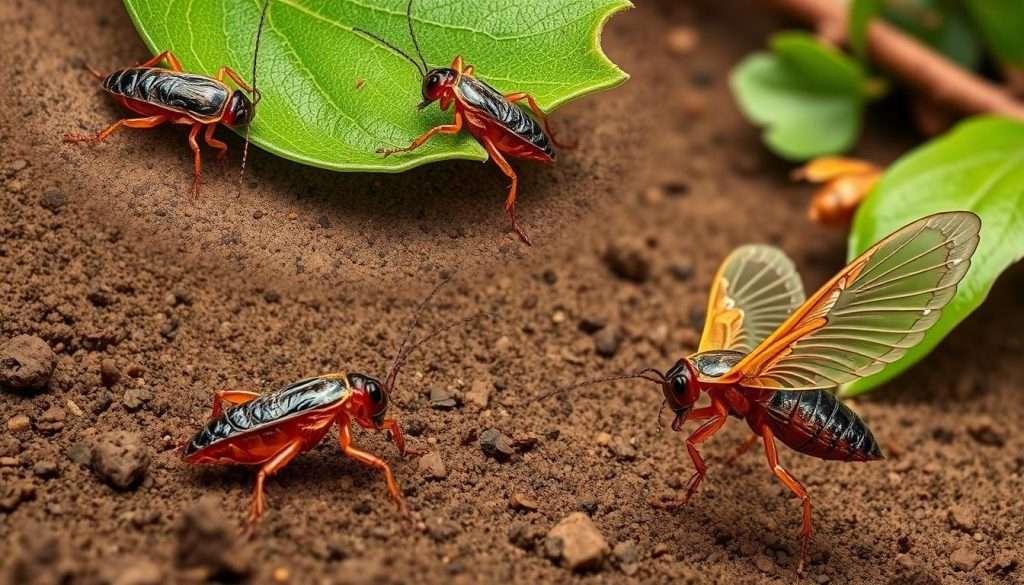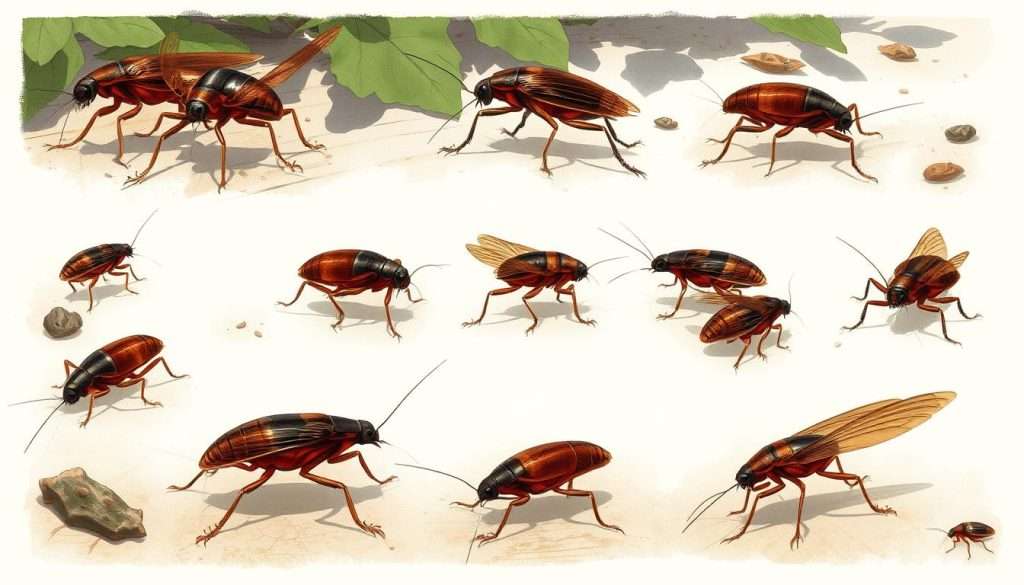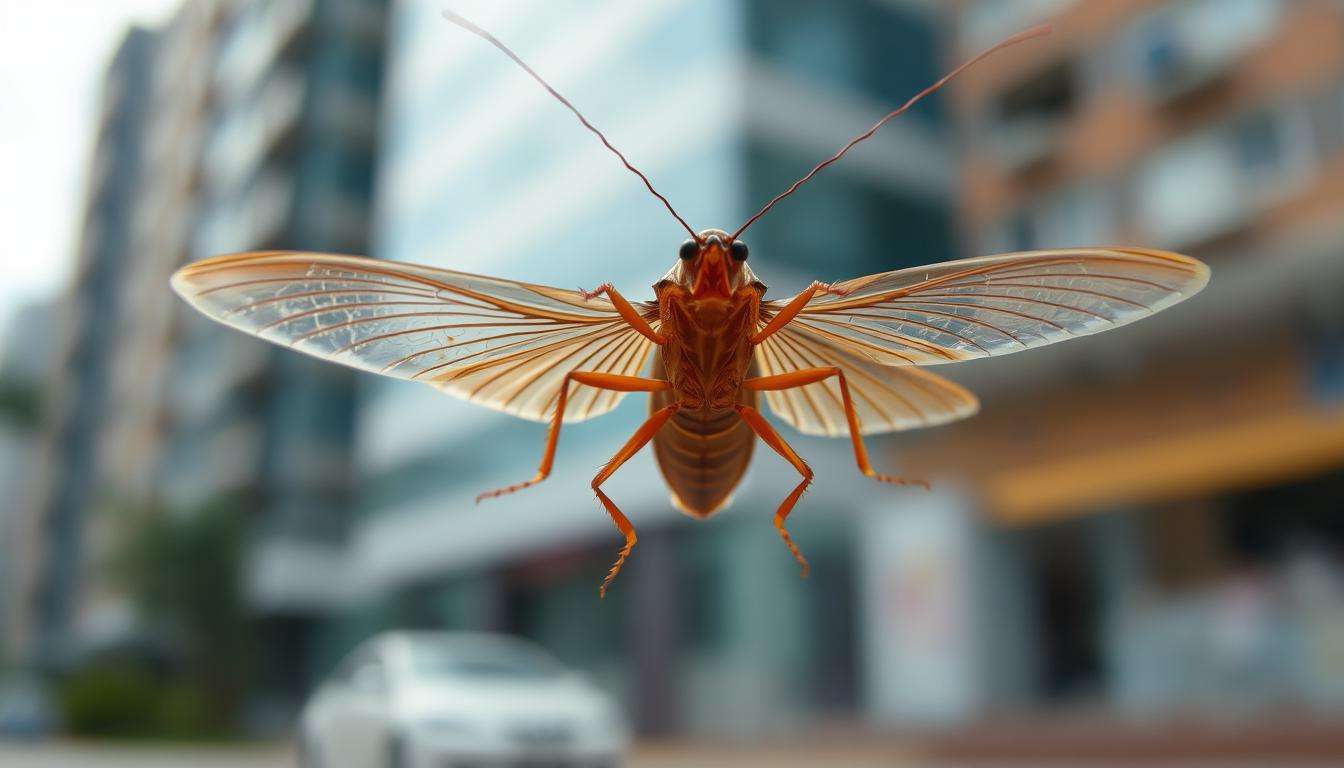Cockroaches are often seen as dirty pests. But, they can fly, which might surprise you. In the U.S., there are about 55 types of cockroaches. Many have wings, but most don’t fly much.
It’s key to clear up what people think about these bugs. Only a few can really fly. They usually move by walking. Flying cockroaches are more active in warm weather, looking for heat to fly.
For more info on flying cockroaches, check out this resource. Knowing the facts helps you deal with cockroaches at home.
Key Takeaways
- Majority of cockroach species have wings but can’t sustain flight.
- Most household cockroaches do not fly at all.
- True fliers include species like Australian and Asian cockroaches.
- Flying cockroaches are more active in warmer temperatures.
- Understanding their behavior is key for effective pest control.
- Flying cockroaches can enter homes through windows and doors.
Understanding Cockroach Flight Capabilities
Cockroaches are often misunderstood, especially about flying. Some can fly, while others can’t. Knowing which types of flying cockroaches live where helps us understand them better. Their flying skills vary by species and environment.
Types of Cockroaches That Can Fly
Here are some flying cockroach species:
- American Cockroach (Periplaneta americana): Grown ones can fly up to 100 feet when it’s hot.
- Turkistan Cockroach (Blatta lateralis): Males can fly with their long yellowish wings. Females can’t.
- Brown-banded Cockroach: Only males can fly, showing off their cockroach flight capabilities.
- German Cockroach: They can’t fly but might glide a bit when scared.
- Oriental Cockroach: They can’t fly or glide and like damp places.
Knowing how to identify cockroach species by their flying skills helps fight infestations.
Differences Between Flying and Gliding
Many cockroaches have wings but don’t fly well. They mostly glide. The main differences are:
- Flying: Some, like the American and Turkistan cockroaches, can fly when needed.
- Gliding: Most glide from high places when scared.
Cockroaches usually fly in response to heat or danger. Their flight is awkward but effective. Knowing about cockroach flight capabilities helps homeowners deal with cockroach problems.
Can a Cockroach Fly? Common Misconceptions
Many people think cockroaches can fly, but it’s not always true. While some cockroaches have wings, they don’t fly much. They usually run away instead.
Cockroaches only fly when they’re scared. This can lead to fast infestations because they hide and spread quickly. Knowing how cockroaches behave helps us understand why they don’t fly as much as we think.
Why Most Cockroaches Don’t Fly Frequently
Cockroaches don’t fly often because of their body and behavior. Even though some can fly, they don’t do it much. This is because:
- They have weak muscles that make flying hard.
- They prefer to run away from danger.
- They save energy by moving on the ground instead of flying.
Knowing these things helps us pick the right pest control methods. These methods focus on stopping their reproduction and hiding spots.
The Role of Temperature in Cockroach Flight
The temperature influence on cockroaches affects their flying. When it’s warmer than 85 °F, they are more likely to fly. Here are some important points:
| Temperature Range | Flight Behavior |
|---|---|
| Below 70 °F | Rarely flies; prefers running. |
| 70 °F – 85 °F | Occasional flight; more active. |
| Above 85 °F | Increased flight activity; likely to escape. |
Temperature and humidity make cockroaches more likely to fly. Keeping your home’s conditions right is key to managing pests.

Cockroach Species Identification by Flight Ability
Knowing how different cockroach species fly is key to spotting them. Some can fly, while others crawl. This affects how we see these pests at home. Let’s look at flying cockroaches, those that can’t, and what makes flying ones special.
Species That Are Capable of Flight
Some cockroaches can fly. Here are a few examples:
- American Cockroach (Periplaneta americana) – Common in cities like Dallas, but they only fly when needed.
- Australian Cockroach (Periplaneta australasiae) – These are great fliers, showing off their agility in the air.
- Brown-Banded Cockroach (Supella longipalpa) – Only males can fly, often when they’re disturbed.
- Smoky Brown Cockroach (Periplaneta fuliginosa) – Can glide a bit and is found in the southern U.S.
Species That Cannot Fly
But many cockroaches can’t fly:
- German Cockroach (Blattella germanica) – A common pest in homes, with small wings.
- Oriental Cockroach (Blatta orientalis) – Can’t fly because it doesn’t have wings.
Key Characteristics of Flying Cockroaches
Knowing what flying cockroaches look like helps in controlling pests:
| Species | Wing Development | Typical Scenarios for Flight | Flight Distance |
|---|---|---|---|
| American Cockroach | Fully developed | Searching for food, moisture, or when threatened | Up to 100 feet gliding |
| Australian Cockroach | Fully developed | Searching for mates or food | Short distances, agile in flight |
| Brown-Banded Cockroach | Fully developed (male only) | When disturbed | Short bursts |
| Smoky Brown Cockroach | Fully developed | Seeking higher ground, especially at night | Short distances |
Most cockroaches don’t fly but are fast on the ground. Their flying is linked to threats or weather. Knowing this helps homeowners fight pests better.
Cockroach Behavior Patterns and Their Influence on Flight
Cockroaches have interesting behaviors that affect how they fly. Knowing these patterns helps homeowners prevent cockroach invasions. Most cockroaches are active at night, which affects their flight. They are also drawn to light, which can lead them into our homes.
Nocturnal Activity and Flight Behavior
Nocturnal cockroaches are most active at night. This means they fly mostly at night to find food or escape danger. For example, the American cockroach glides at night to move around.
Female cockroaches live longer and use the night for mating and finding food. This gives them more chances to fly.
Attraction to Light and its Impact
Cockroaches are attracted to light, which brings them closer to our homes. Species like the Smokybrown and Asian cockroaches fly towards light in the summer. This can lead to infestations in our homes.
Knowing this helps us fight cockroach infestations. We can reduce outdoor lights near our homes. Using natural repellents can also keep them away from indoors.

Pest Control Methods for Flying Cockroaches
Effective pest control methods are key to managing flying cockroaches. A good strategy involves understanding these pests and taking steps to keep them away. It’s important to find and block their entry points to keep your home pest-free.
Developing a Pest Management Strategy
Begin by making a detailed pest management plan. It should include several steps:
- Regularly clean your home, focusing on food and moisture, to deter flying cockroaches.
- Remove cellulose-based items like newspapers and cardboard that attract cockroaches.
- Seal cracks, gaps, and holes around windows, doors, and walls to block entry points.
- Reduce wood piles and debris around the house, as cockroaches are drawn to wooden environments.
- Consider using insecticides formulated for cockroaches, applied to infested areas and as a perimeter treatment.
Preventing Cockroaches from Entering Your Home
To keep flying cockroaches out, take proactive steps:
- Fix leaks and ensure proper ventilation to eliminate moisture hotspots.
- Install door sweeps and screens to create barriers against flying cockroaches.
- Perform regular inspections of less accessible areas like basements, kitchens, and bathrooms.
- Maintain a clutter-free environment, as cockroaches prefer hiding spots.
- When facing extensive infestations, consulting with professional pest control services like Lake Norman Home Services can provide effective solutions.
Using these methods will help you fight flying cockroaches effectively. This ensures a safe and peaceful home environment.
| Pest Control Method | Description | Implementation Tips |
|---|---|---|
| Regular Cleaning | Eliminates food and moisture sources | Focus on kitchens and dining areas |
| Sealing Entry Points | Prevents cockroaches from entering | Inspect windows, doors, and cracks |
| Moisture Control | Stops attraction to damp areas | Repair leaks and enhance ventilation |
| Professional Pest Control | Provides effective treatment options | Choose experienced services for infestations |
| Insecticides | Kills roaches and prevents future infestations | Target areas where cockroaches hide |
Conclusion
Exploring cockroach flight shows us how to keep our homes safe. About 3,500 out of 4,500 cockroach types can fly. Knowing which ones can and why is key to fighting pests.
Species like the American and Australian cockroaches are big concerns. They can grow up to 40mm and are more active in warm weather.
Flying cockroaches can travel far, but they’re a health risk inside. They can spread diseases like salmonella. Knowing how to control them is important.
Understanding what makes cockroaches move can help us fight them. They like warm temperatures, between 24 and 29 degrees Celsius. This knowledge helps us keep our homes pest-free.
Being ready and knowing how to deal with cockroaches is crucial. It helps us keep our homes safe and comfortable. This way, our homes stay a safe place for us.
